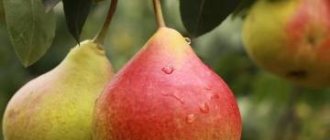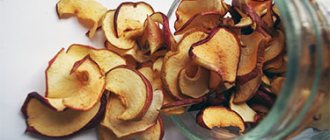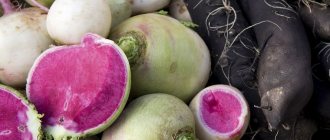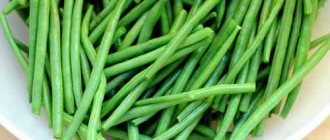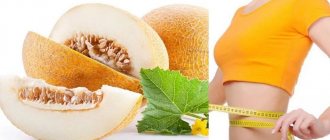Author: Kristina Lobanovskaya, doctor, practicing nutritionist Article updated: 11/09/2020
Pears are the fruits of the tree of the same name in the Rosaceae family. The place of its origin still causes heated debate today: some sources call the region between the Black and Caspian Seas its homeland, others consider the pear tree to be a native of the Urals, and still others are confident that the pear comes from Central Asia. One thing is clear: the fruits of the tree are an amazingly tasty and extremely healthy product. On average, the calorie content of a pear per 100 g is 46 kcal, which means it can be eaten with
Fresh
The first varieties of pear were unsuitable for fresh consumption, that is, they required heat treatment. But even then the fruits were served at the table of noble people in many European countries. Much later, the first cultivated edible variety was developed. Soon he appeared in Russia.
Traditionally, the fruits are shaped like a light bulb, but cylindrical and round ones are also found. The “palette” of pears is colorful and varied: there are red-orange, light or dark yellow, brown, green and even white-transparent. In general, today the world knows more than 30 varieties of fruit, which explains the difference in the hardness of the peel and the juiciness of the pulp. But “graininess” is characteristic of almost all types, as is a slightly tart aroma. By the way, the riper the fruit, the richer the latter.
The average calorie content of a ripe pear is determined to be 46 kcal per 100 grams (the calorie content of a green pear is no more than 42 kcal), however, each variety can boast of its own indicators. The most popular are:
- Abbot. Quite large fruits with thin, rough skin, colored yellow-green, and juicy pulp, distinguished by sweetness. Calorie content per 100 g – 46 kcal.
- Williams. Medium-sized fruits with a lumpy surface, thin shiny skin of light green color, which becomes bright yellow when ripe. The pulp is white or slightly yellowish, tender and juicy. Its peculiarity is a wine-sweet taste with a slight aroma of nutmeg. Calorie content per 100 g – 48 kcal.
- Dichka. The fruit, ripening on a wild tree, is small in size and ovoid in shape. Covered with thin but rather dense skin. At the ripening stage it has a golden yellow color and sweet and sour yellow flesh. Calorie content per 100 g – 42 kcal.
- Duchess. The fruit of the Duchess variety is not overly large in size, has a pear-shaped shape and an uneven surface, covered with a thin bright yellow skin. The pulp is painted in a delicate cream color, juicy and slightly “nutmeg”. Calorie content 100 g – 42 kcal.
- Conference. The fruits are large in size and elongated in shape and have a yellow-green color. The skin is quite tough, with a matte tint, but the flesh is tender and juicy, literally melting in your mouth. Due to the tannin content in the skin, a slight astringency is felt. Calorie content per 100 g – 49 kcal.
- Forest beauty. The fruit is medium in size, oval in shape. The golden-yellow skin is characterized by thinness, and its surface may be dotted with specks of a rusty hue. Sometimes the “sunny” side acquires a blush. The pulp is juicy and tender. Calorie content per 100 grams – 41 kcal.
- Lucas. Quite large fruits are covered with yellow skin with a slight reddish blush. The pulp is harsh and grainy, not too sweet, but juicy. 100 grams contain 44 kcal.
- Packham. The voluminous and fairly large fruits have an uneven, rough, green surface. The light creamy flesh has an unusual aroma and juiciness, and is considered quite crispy. The fruit has a sweet and sour taste. Calorie content per 100 g – 42 kcal.
- Santa Maria. The peculiarity of the variety is its incredibly tender pulp, striking in its juiciness. There is no granulation. The color of the pulp can be described as slightly yellowish or even white. The skin has a pinkish tint. The calorie content of the variety is 43 kcal per 100 grams.
- Northern woman. The fruits are small in size, have a conical shape, and are yellow with a slight green color. The skin is quite dense. The cream-colored pulp is slightly aromatic, but juicy and crispy. Astringency is not inherent in the variety. Calorie content 100 g – 42 kcal.
- Trout. The pear is not large in size, but has a rainbow color, which is why it is compared to trout. The skin is smooth, not too tough. The creamy flesh is sweet and juicy. The peculiarity of the variety is a pleasant aftertaste with cinnamon notes. Calorie content per 100 grams – 42 kcal.
Important! In addition to its low calorie content, fresh pears have another advantage - a low glycemic index of 30 units.
A completely unique fruit is the Chinese pear of the Yali variety, which is also called “Nashi”, “crystal” or “sand”. This is nothing more than an apple-pear, that is, a hybrid. The shape of the fruit only emphasizes the simultaneous similarity with both fruits. The size of Nashi is not particularly large - the weight of one fruit is about 200-300 grams. The skin of the crystal pear has a subtle yellow color (sometimes called “white”) and hides the unusually juicy, tender flesh. A pleasant feature of Nashi is the harmonious combination of sweetness and piquant sourness. The calorie content of a Chinese pear is 42 kcal per 100 g. By the way, among all varieties it is considered the most suitable for a dietary diet, since it contains a record amount of dietary fiber.
In general, the fruit, regardless of the variety, has many beneficial properties. Since it is classified as a low-calorie product, you can eat the fruit without fear of spoiling your figure and include it in your diet for weight loss. Nutrition experts consider it a good idea to include juicy pulp in the menu of an obese person. Among other things, the low glycemic index allows the product to be used by diabetics.
The value of pears as a food product is recognized by official and traditional medicine, and all thanks to its multifaceted composition: pectins, organic acids, macro- and microelements, vitamins. The substances help strengthen the immune system, making the fruits a good remedy for the prevention of viral and infectious diseases. Their regular use helps cleanse the body of waste and toxins, and also helps in the fight against depression: the essential oils contained in the composition improve mood and increase vigor.
Among other beneficial properties of the fruit:
- normalization of digestion;
- elimination of unpleasant symptoms of gastritis and cholecystitis;
- relief from insomnia and nervous disorders;
- providing a diuretic effect and eliminating swelling;
- positive effect on the cardiovascular system and hematopoietic processes;
- cell renewal.
Important! A pear without a peel seems juicier and more aromatic, but you should be aware that when consuming the product, a person is depriving himself of a valuable source of fiber contained in the peel.
It has been proven that pear is a natural antidepressant that can increase the body's resistance to pathogens. What gives the fruit its sweetness is not glucose, as in the case of an apple, but fructose, so it is useful for people with problematic pancreas.
When choosing fruits, you just need to rely on your own sense of smell: if they are fragrant, then they are ripe and tasty. Such pears keep well for several days even if there is no refrigerator. But be sure to pay attention to the appearance, beware of dents, dark spots and rot.
In culinary terms, the fruit is universal: it is suitable as an ingredient in salads and appetizers, fillings for pies and game, and drinks; goes well with mint, cheeses, honey, arugula, nuts and spinach. The fruits are canned, dried, baked. Jams, jams, and confitures are prepared from them. Moreover, after heat treatment, the beneficial properties are preserved, since the amount of vitamins and minerals does not decrease in comparison with fresh fruits.
Frozen
Making pies, rolls and other baked goods using pears is one of the good ways to cheer up in winter. Many people use pear jams for such purposes. However, often baking with them turns out cloying. It is much healthier to cook using frozen pears, which retain a maximum of vitamins and have a low calorie content - 47 kcal per 100 grams.
Before freezing, the fruits are washed and cut into slices, after removing the core and tail. If desired, the skin can be peeled. The prepared slices are laid out on a tray covered with parchment, so that they do not touch each other. In this form, they are sent to the freezer for 1 hour, after which they are put in a plastic bag or a special container and returned to the freezer again.
Since a frozen pear retains the beneficial substances inherent in fresh pears, it exhibits similar properties: benefits for digestion, elimination of puffiness, and value for weight loss. If you do not plan to use the fruit for weight loss, you can freeze it using sugar: the slices are mixed with granulated sugar, wait for the juice to release, and put it in the freezer. This product should be stored in a container.
Contraindications
All beneficial properties of the product appear only if consumed in moderation and following the rules. If they are violated, the fruit can cause significant harm to health. To avoid this, you need to know about some contraindications for use:
- age up to 1 year;
- bleeding gums;
- diabetes mellitus type 1 in severe form;
- hypersensitivity to the product;
- tendency to allergic reactions;
- chronic enteritis or colitis in the acute stage;
- severe gastritis with frequent relapses;
- peptic ulcer with threat of perforation of the stomach wall;
- persistent constipation that becomes chronic;
- increased gas formation on an ongoing basis.
You should not use the product in combination with other fruits that contain a large amount of fiber: this often provokes persistent constipation and severe pain in the abdominal area.
If the recommendations are not followed, a person may experience side effects such as:
- indigestion;
- heaviness, epigastric pain;
- exacerbation of chronic pathologies of the digestive system;
- spasms of intestinal smooth muscles.
An allergic reaction to the fruit is accompanied by itching, flaking, hyperemia, and a rash on the skin. Usually, to eliminate such symptoms, it is enough to stop taking the product. If the symptoms do not disappear, it is recommended to consult a doctor.
Canned
Preservation is a traditional way to preserve the juiciness and taste of fruits for a long time. Since the harvested crop is often unripe or too hard, it is perfect for creating such preparations. The calorie content of canned pears is 43 kcal for every 100 grams when the process occurs at home and the product remains free of harmful additives in the form of preservatives, dyes, and sweeteners. Glass jars are used for canning.
If preservation occurs under industrial conditions, that is, concentrated sugar syrup is used, the calorie content increases to 65 kcal per 100 grams. Manufacturers often prefer tin containers. If stored properly, the finished product can be stored for up to 3 years.
You can use canned fruits as an independent dessert or include them in various dishes, such as snacks and salads. You can also prepare creams and compotes based on them.
Rating of food delivery for weight loss
Delivery of food with calculated calorie content, ready-made diets. No more cooking and counting calories!
Go
Go
Features of use
The most preferable option is to eat pears with their peels raw.
Those who suffer from any pathologies of the gastrointestinal tract are recommended to bake fruits in the oven or microwave without sugar. This will allow you to benefit from the product without harming your digestion.
Dried fruits are recommended to be consumed in limited quantities, since their calorie content is high. 50 g per day is enough to compensate for the deficiency of useful components. Canned fruits using a minimal amount of sugar are best for young children who do not want to eat fresh fruits. Pear in wine syrup is suitable for dessert. Consumption is permitted only for adults and in limited quantities.
The daily intake of fresh fruit for an adult is 2 medium-sized pieces. For a child from 7 years old, 1 pear is enough; from 3 to 7 years old, 50 g of pulp without peel is the norm. Up to 3 years old, you should give your baby no more than a piece. Women during pregnancy should not exceed a dose of 150 g of product.
Dried
The calorie content of dried pear is 249 kcal per 100 grams. The indicator is not low, but it more than pays for itself with the set of useful qualities of the product. In folk medicine, such a preparation is akin to a diuretic, disinfectant, antitussive and antipyretic medicine. The dried product contains organic acids, enzymes, tannins, as well as phytoncides and flavonoids. Of particular value are nutritional fibers that have a beneficial effect on the digestive tract. Dried fruits do not contain sugar syrup - their sweetness is purely natural. Due to the high potassium content, the product is very useful for cardiovascular diseases. Experts say that dried pears should be included in the diet of anyone who experiences such unpleasant symptoms as rapid heartbeat, dizziness, fatigue and loss of appetite.
In cooking, dried (aka dried) product is in demand. It goes well with cottage cheese and fermented milk products, as well as porridges, and is suitable for making jelly, compotes, and decoctions. By the way, pear compote is rich in tannins, which have an astringent effect and are valuable for intestinal disorders.
Preparing dried fruits at home is not a problem: they are washed, peeled, cut into slices, removing the seeds. Then lightly blanch and dry in a convenient way: in the oven, microwave or a special electric dryer. The process continues for 20-60 minutes. The finished slices are stored in a plastic or glass container with an airtight lid.
Calorie content of jam
Fragrant amber jam is in demand among people of all ages. To prepare the delicacy, fruits from the summer and autumn harvest are chosen. Prepared in slices or whole with the addition of a large amount of sugar. Therefore, the caloric content of jam is high and using it for weight loss is unlikely to be beneficial.
But for some diseases, jam brings invaluable benefits. These include diseases of the pancreas, heart and vascular system. Jam and jam are useful for sick kidneys and liver, and are indicated for prostatitis. And the whole point is that heat treatment does not destroy the beneficial properties of the pear, which means the jam remains not only a tasty delicacy, but also a valuable medicine.
Attention. For some diseases, eating pears is contraindicated, while jam, on the contrary, is a recommended product. Do not miss the opportunity to use the beneficial qualities of the pear, especially since its features are not lost during processing.
Tsukatov
Scatterings of sweet, colorful fruit pieces are in demand today in home cooking. Among the variety of aromatic dried fruits, candied pears are popular. Unfortunately, when producing candied fruits, manufacturers often use harmful food additives, which not only poison the body, but also increase the calorie content of the finished product. For comparison, candied fruits prepared industrially have a calorie content of 343 kcal per 100 g, while those made at home have no more than 200 kcal for the same amount.
Making homemade candied fruits is easy. First, you need to decide on the preferred size of the finished product: pears can be cut into small pieces, creating a semblance of store-bought candied fruit, or you can use halves without even removing the stem. For 1 kg of hard fruits take 1 kg of sugar, a glass of water and 1 teaspoon of citric acid. First, prepare the syrup: combine sugar, citric acid and water in a bowl, heat it over high heat and wait until the sugar is completely dissolved. The fire is reduced. The syrup is allowed to simmer until transparent. Pears are placed in boiling syrup. Turn off the heat, remove from the stove and leave overnight. The next day the bowl is returned to the heat. After boiling, boil for 10-15 minutes. On the third and fourth days the process is repeated. On the fifth day, boil for at least 1 hour. Remove the pears from the syrup with a slotted spoon and place them on parchment. After 3-4 hours, the finished candied fruits are sprinkled with powdered sugar (during storage it melts and turns into sugar glaze) and placed in a glass container.
Candied fruits have the same effect on the body as fresh fruit: they normalize the functioning of the digestive system, improve metabolism, help with the functioning of the cardiovascular system, etc. They can be used to prepare pies and casseroles, light salads and drinks.
Daily intake of pears
We recommend reading our other articles
- Vidnaya pear variety
- How to make feed for rabbits
- Zukesha's zucchini
- Cabbage variety Gift
Many people are interested not so much in the calorie content of a pear, but simply in the daily consumption rate. Women can eat about 3-4 medium-sized pears per day. For men, the norm increases to 5 pieces. If we talk about children, then they should eat up to 1.5 small pears or approximately 200 g per day.
Interesting!
The more aromatic the pear, the richer its vitamin composition. So, when buying fruit at the market or in a store, you can focus specifically on the smell.
Children can eat up to 1.5 small pears or about 200 g per day
Dishes
Pears are not only a healthy sweet, but also a product suitable for fasting days and diets that can replace dinner. To get maximum benefits for your health and figure, fruits do not have to be consumed only fresh: they can be baked, used to make juice and puree. The beneficial properties and vitamin and mineral composition are preserved after heat treatment, but the calorie content varies depending on the cooking method and the products used in the process of creating the dish.
baked
Baked pear is a dessert that can be prepared both during the ripening period, using fresh fruit, and in winter, if you first freeze the fruit. Calorie content depends on the chosen recipe. Two were recognized as the best:
- The fruits are washed, wiped dry, cut into two halves and the core is removed to create a recess. Chop some plums, nectarines and grapes. It's also good to take lingonberries. The fruits are mixed and the halves of the fruits are filled with the mixture. Bake in the microwave for about 3 minutes at a power of 2000 W. The finished dish is sprinkled with a small amount of coconut flakes. The peculiarity of the recipe is the complete absence of sugar. The calorie content of this aromatic and healthy dish in all respects is 95 kcal per 100 grams. Those losing weight can eat it as a snack or dessert.
- Take several large fruits. Wash, dry and cut into small slices, removing the core and stalk. The workpiece is placed in a baking dish, previously covered with parchment. Grease with butter and sprinkle with a little sugar. Place in the oven for 10-15 minutes and bake at 180 degrees. There are 161 kcal per 100 grams. The recipe is of medium calorie content, that is, you shouldn’t get carried away with it while on a diet. By the way, it is recommended to serve the pear prepared in this way hot with ice cream.
Boiled
Pear boiled in spicy syrup is a recipe that can be found in expensive restaurants. It's even better to cook the dish yourself. Low calorie content - 73 kcal for every 100 grams - and exquisite taste allow the dish to diversify the diet.
Pour 1 liter of water into the pan. Add cinnamon, cloves, honey, cane sugar, orange zest and lemon juice. The amount of ingredients can be adjusted independently. Cook for 30 minutes. Several hard pears are peeled, leaving the tails. Place in syrup and boil for 20 minutes until soft. The finished fruits are placed on a plate and poured with syrup.
Juice
Naturopathic doctors classify pear juice as a dietary and even medicinal drink, since it not only normalizes digestive functions, but also performs many other functions: removes waste and toxins from the body, strengthens the immune system, helps in weight loss, etc. It is useful for cystitis, neuritis, urolithiasis. The juice has analgesic, antibacterial and antiseptic properties. The fructose contained in the drink makes it an excellent medicine for the treatment of thyroid diseases, and sorbitol, which is sufficient in the juice of unripe fruits, strengthens capillaries and helps patients with diabetes.
The calorie content of high-quality juice, that is, prepared at home from fresh fruits without the use of sugar and harmful additives, is 46 kcal per 100 g.
Smoothie
Smoothie with pear is an excellent option for a diet breakfast and healthy snack. The calorie content of 100 g is 77 kcal. To prepare, take one pear, which is peeled and cored, and then chopped into small pieces; one banana, cut into pieces; 50 g of cottage cheese and 70 g of natural yogurt. Whisk all components using a blender and pour into a glass.
Compote
There are many recipes for making fruit compote. They differ in additional components and, naturally, in calorie content.
Compote with cinnamon is recognized as the most fragrant, the calorie content of 100 g of which is no more than 30 kcal. To prepare, take a few cinnamon sticks, put them in a saucepan and pour a liter of boiling water. At the same time, take 2 large pears and 1 apple. Wash, remove the core and stalks, cut into small cubes. Pour 2 liters of water into the pan, add pears and apples. Bring to a boil, then add a little sugar. Cook for about 20 minutes. When it cools down a little, add cinnamon water and put it in the refrigerator to infuse.
The calorie content of compote with the addition of exotic kiwi fruits is even lower - only 18 kcal per 100 g. Take 200 grams of pre-peeled and chopped pears. Fill with 1.5 liters of cool water and put on fire. They wait until it boils. Let it boil for about 20 minutes, after which add 100 g of kiwi and 2 teaspoons of granulated sugar. Cook for another 5 minutes.
Pear-mint compote has a similar calorie content. To prepare, take 300 ml of water, 20 g of pear, 5 g of dried mint and a teaspoon of granulated sugar. This recipe does not require cooking the fruits for a long time: 5 minutes after boiling, add the remaining ingredients, let it boil and turn off the heat. Thanks to this trick, the drink becomes extremely useful.
Kiselya
You can make aromatic jelly from pear-based compote. The one for which fresh fruit was used is less nutritious - 65 kcal per 100 g. First, the compote itself is cooked, for which you take 1.5 liters of water, 3 ripe pears, 150 g of raspberries and 150 g of blueberries. 200 g of sugar is used as a sweetener. As soon as the compote is ready, pour in a mixture of 150 ml of water and 5 tablespoons of potato starch in a thin stream. Wait until it boils again and remove from heat.
Another way to prepare aromatic jelly is to use dried pear compote. For 1.5 liters of water, 200 g of dried fruits and 100 g of granulated sugar are required. Unlike the first recipe, jelly is prepared from pure compote, that is, the drying is removed. The calorie content of dried fruit jelly is 73 kcal for every 100 g.
Puree
Pear puree is a popular product that is used in children's and dietary nutrition, served as a healthy dessert, and used in baking. The calorie content of puree for every 100 g is 52 kcal. It preserves the taste of fresh fruit and does not change its vitamin and mineral composition. Eating puree helps strengthen the immune system and is good for the digestive tract.
Prepare puree at home. Ripe fruits, washed and peeled, are rubbed through a sieve. Sugar is not added because the puree is sweet. If you want to diversify the dish, you can additionally add honey and walnuts (for 1 fruit there is a tablespoon of honey and 2 tablespoons of kernels). In this case, the puree will become more satisfying, but the calorie content will also increase to 152 kcal for every 100 g.
Jam
The calorie content of classic pear jam is 185 kcal per 100 g. This is an excellent independent dessert that looks no less advantageous in various baked goods and is combined with the same pancakes.
Fruits for making jam should be taken slightly unripe. To obtain a 1.5 liter jar, 1.2 kg of fruit is required. They are washed. Remove the skin from each pear (do not throw it away) and discard the core. The stalks are also removed. Each fruit is cut into two halves. Next, put the peel into an enamel container, add 1 kg of sugar and add a teaspoon of citric acid. Pour the ingredients into a glass of water and mix. Place the bowl on the fire and, stirring constantly, bring to a boil. Boil for two minutes, skimming off the foam. Boiling syrup is poured over the prepared pears and left to steam for 5-6 hours. Afterwards, the syrup is drained and brought to a boil. Pour the fruits again and leave for 5 hours. The third time, cook the jam until ready: first keep the bowl over high heat and, stirring, bring to a boil, and then simmer on low for an hour. A little syrup with the skin is poured into a sterile jar, after which the pear halves are placed. Cover the jar with a sterile lid and allow to cool.
An unusual way to make jam is boiling it with milk. The result is not even jam, but milk jam with a calorie content of 165 kcal per 100 g. In this case, the fruits are taken ripe. Wash, peel, cut into small pieces and puree using a blender. Sugar is added: for 1.5 kg of fruit take 1.2 kg. Excess liquid is evaporated over medium heat for 1 hour, after which the jam is allowed to cool. Return to the heat again and pour in 1 liter of milk. Cook for 40 minutes. Cool, then cook again until boiling and pour into prepared jars.
In fact, there are plenty of recipes for pear jam; it can be prepared using apples, peaches, nuts and even poppy seeds.
Pirogue
Baking always comes out quite high in calories, so it is considered not the best choice for a therapeutic diet and nutrition for weight loss. There is a solution - pear-apple quiche. Such a pie has a calorie content of 178 kcal per 100 g, which means that it may well sometimes end up on the table of a limited diet. Since the pie is open, there is not much dough in it.
Pour 1 cup of sifted flour into a container. Add 80 grams of frozen butter, cut into cubes. Grind flour and butter until crumbly. Add 3 tablespoons of ice water and knead the dough. Refrigerate for 30 minutes. At this time, prepare the filling. Cut 2 apples and 2 pears into cubes. The frying pan is greased with butter. Lay out the fruit, sprinkle with sugar and put on the fire. As soon as the juice appears, cover with a lid and wait 7 minutes. Let it cool. The dough is rolled out and placed in a baking dish, preferably round. Form the sides. Lay out the filling and distribute. Pour in a mixture of one chicken egg, 4 tablespoons of milk and a pinch of sugar. Sprinkle with cinnamon. Place in an oven preheated to 180 degrees for 25 minutes.
Salatov
A light salad with pear with a calorie content of 66 kcal per 100 g perfectly saturates and provides the body with a supply of vitamins. To prepare it, take 1 ripe pear, 1 apple, 1 orange and 6 tablespoons of sweet white wine. The ingredients are peeled, cut into small pieces, placed in a bowl and poured with wine.
Pears can be used not only in fruit salads. When canned, it goes well with boiled beets. The salad has a fairly high calorie content - 203 kcal per 100 g - but at the same time it satisfies well, so it can act as an independent meal. One boiled beet is peeled and cut into small plates. 100 g of canned pears, cut into small pieces. Place it on a plate, maybe in the shape of a flower. Sprinkle a handful of fresh chopped dill on top. Add a little salt and ground black pepper. Pour 3 tablespoons of olive oil and 1 tablespoon of lemon juice into a bowl. Add a teaspoon of sesame seeds. Mix everything well. Pour the dressing over the salad.
Fresh fruits, in the absence of canned ones, can be combined with cucumbers. 100 g of this salad contains 72 kcal. One medium-sized fresh cucumber, peeled and cut into cubes. 2 juicy pears are also peeled and chopped. 10 g of raisins are briefly steamed in hot water, after which the water is drained. 20 g of walnuts are crushed. Combine all ingredients, sprinkle with a teaspoon of granulated sugar and sprinkle with lemon juice.
Another option for an interesting pear salad is with chicken breast. It can be called dietary: per 100 g there are only 77 kcal. First, boil 300 g of chicken breast. There is no need to salt the water. Cool and cut into small cubes. Prepare 2 ripe pears in the same way. One onion is chopped not too finely and soaked in water for 5 minutes. Afterwards, all the ingredients are mixed in a bowl, poured with a few teaspoons of wine vinegar, sprinkled with a pinch of sugar and ground red pepper.
Cream soup
Appetizing creamy pear and pumpkin soup is perfect for a morning meal and can be a good alternative to a hearty dinner. The calorie content of cream soup is not too high - 132 kcal per 100 g.
The pumpkin is cleaned, the seeds are removed and 250 g of pulp is separated, which is crushed into small cubes. Chop the onion in the same way. Heat 75 g of butter in a saucepan. Add onions and fry. Add pumpkin and a little curry. Fry for about 7 minutes with constant stirring. Several pears are peeled and cored and cut into cubes. Add to the pumpkin and onion, add water (it should cover all the components of the soup). Boil for about 20 minutes, after which the mass is turned into puree using a blender. Add a small amount of sour cream and beat again. Bring to a boil, remove from heat and cover with a lid. To decorate the cream soup, use fried slices of fresh pear and sesame seeds.
The nutritional value
Pear is the case when a product is both tasty and healthy. Thanks to its multifaceted chemical composition, its regular use helps eliminate the deficiency of many vitamins and minerals. The fruits actually contain a high content of organic acids, and also contain dietary fiber, mono- and disaccharides. Taking into account the low calorie content of the fruit, it becomes obvious that it is simply necessary to include it in the diet, especially when trying to lose weight without harm to health.
Proteins fats carbohydrates
The BJU ratio is especially important for those losing weight. When consuming fresh fruits, the calorie content of which is 46 kcal, it is possible to obtain the following values:
- proteins – 0.4 g;
- fats – 0.3 g;
- carbohydrates – 10.3 g.
Since fresh fruit contains as much as 88% carbohydrates, along with the benefits for the body, it is possible to get long-term saturation and a boost of energy. By the way, the composition of the BZHU of the Chinese pear, whose calorie content does not exceed 42 kcal, is not much different:
- proteins – 0.5 g;
- fats – 0.23 g;
- carbohydrates – 7 g.
Interestingly, freezing does not change the calorie content of the pulp, but completely deprives it of proteins and fats, leaving 100% carbohydrates.
100 g of canned fruit with a calorie content of 43 kcal contains:
- proteins – 0.4 g;
- fat – 0.3 g;
- carbohydrates – 10.3 g.
After drying, not only the calorie content of the fruit increases, amounting to 249 kcal for every 100 g, but the BJU indicators, especially in relation to carbohydrates, also undergo changes:
- proteins – 2.3 g;
- fats – 0.6 g;
- carbohydrates – 62.6 g.
Candied fruits have a calorie content of 343 kcal per 100 g and the following BJU values:
- proteins – 0 g;
- fats – 0 g;
- carbohydrates – 91.6 g.
100 g of baked pulp contains 95 kcal. It demonstrates the following BJU indicators:
- proteins – 2 g;
- fats – 5 g;
- carbohydrates – 10 g.
After boiling, 100 g of product contains 73 kcal and:
- proteins – 1 g;
- fat – 0 g;
- carbohydrates – 16 g.
The predominant amount of carbohydrates in pears allows us to call them “energy landing”.
Macro- and microelements
The mineral composition of pears can be the envy of many products. Along with known and common elements, it contains completely unexpected substances.
- Rubidium - the effect of the element on the body is associated with its concentration in a number of organs: lungs, bone tissue, brain; has an antihistamine effect, useful for normal blood circulation.
- Nickel – accumulates in the brain, liver, lungs, kidneys, pancreas and thyroid gland; promotes hormonal regulation, reduces blood pressure and supplies oxygen to tissue cells.
- Cobalt is a substance of particular importance for the normal functioning of the central nervous system, activates metabolism and reduces cholesterol levels in the blood.
- Silicon – the effect of silicon on the body is extensive: it is thanks to it that the elasticity of all organs and tissues, youthful skin and healthy nails are maintained.
- Vanadium - the effect of the substance extends to almost all organs: bone tissue, kidneys, heart, thyroid gland; slows down the aging process and cholesterol production, and also strengthens the body's immune defense.
- Boron - stimulates protein synthesis, regulates the activity of the nervous system and brain, prevents the formation of kidney stones.
- Molybdenum is one of the most important components in the process of tissue respiration; acts as a powerful antioxidant; responsible for metabolic processes.
- Fluorine is found in the body in the form of inorganic compounds; plays an important role in the formation of bones and teeth, preventing osteoporosis, caries and periodontal disease.
- Selenium has a powerful effect on the body, slowing down the aging process, activating the immune system and providing an anti-inflammatory effect.
- Manganese - along with calcium, takes part in the development of bone tissue, and also helps strengthen the immune system and helps the body resist various types of infections.
- Copper is important for the conversion of iron into hemoglobin, participates in the processes of growth and reproduction, and is necessary for the synthesis of the hormone of happiness - endorphin and the formation of collagen.
- Iodine - normalizes the functioning of the central nervous system and improves brain activity, reduces cholesterol levels in the blood, accelerates lipolysis and controls carbohydrate metabolism.
- Zinc is part of more than 300 hormones and enzymes, so it is involved in almost all vital processes of the body, including growth, development and puberty.
- Iron is one of the most necessary elements for the body, participating in the processes of hematopoiesis and intracellular metabolism; additionally regulates immunity and normalizes the functioning of the thyroid gland.
- Sulfur - a macroelement is a prerequisite for healthy hair, skin and nails, and also helps to neutralize and remove toxins from the body.
- Chlorine is important for regulating water balance and performs a number of other functions: it promotes the breakdown of fats, stimulates appetite, and affects the removal of carbon dioxide.
- Phosphorus is a substance necessary for normal kidney function and metabolic processes, regulation of acid-base balance and good functioning of the heart.
- Potassium is an obligatory participant in many metabolic processes, regulates water balance, helps eliminate swelling and activate enzymes.
- Sodium - affects the functioning of the central nervous system, strengthens the cardiovascular system, maintains acid-base balance and stimulates digestion.
- Magnesium - along with improving the functioning of the digestive organs, regulates the functioning of the nervous system and has a beneficial effect on the heart.
- Calcium is the main building substance in the body, responsible for strong bones and healthy teeth.
Since the elements entering the body when eating a pear work together and demonstrate an enhancing effect of interaction, there is a rapid improvement in well-being and the prevention of many diseases.
Vitamins
The aromatic pulp of the fruit is a valuable source of B vitamins, the biological significance of which is great:
- B9 or folic acid - in addition to the most beneficial effect on the intestines and liver, the vitamin supports the immune system and is involved in redox processes.
- B6 or pyridoxine, an “antidepressant” substance, is of particular importance for people prone to stress, as it has a calming effect and protects the nervous system.
- B5 or pantothenic acid - plays a key role in the metabolism of proteins, carbohydrates and fatty acids, while also taking part in reducing cholesterol levels.
- B3 or niacin is classified as a medicinal product by official medicine due to its ability to improve blood microcirculation, reduce cholesterol levels and normalize digestive processes.
- B2 or riboflavin - the vitamin is often called the “engine of the body,” taking into account the participation of riboflavin in all metabolic processes and its positive effect on the thyroid gland.
- B1 or thiamine - takes part in fat, carbohydrate, protein, energy and water-salt metabolism, additionally regulating the activity of the central nervous system.
In addition to this group, fresh pulp contains the following organic compounds:
- Retinol (beta-carotene, vitamin A) – is involved in protein synthesis and promotes normal metabolism, slows down the aging process and supports immunity.
- Phylloquinone (vitamin K) – supports normal kidney function, prevents osteoporosis, has an analgesic and antibacterial effect.
- Biotin (vitamin H) - plays an important role in the metabolism of fats, proteins and carbohydrates, while helping to activate vitamin C and stabilize blood sugar levels.
- Tocopherol (vitamin E) is considered the vitamin of youth, as it acts as a powerful antioxidant and slows down the aging process.
- Ascorbic acid (vitamin C) – protects the body from viruses and bacteria, demonstrates anti-inflammatory effects and regulates metabolism.
The value of the pear as a natural source of vitamins and minerals is beyond doubt, as is the advisability of using it for weight loss. However, before starting regular use, both the benefits and harms should be studied. Regarding the latter, little can be said: it is better not to use fruits in excessive quantities, so as not to burden the digestive organs, and not to consume on an empty stomach in order to avoid irritating the intestinal mucosa and simultaneously with heavy foods.
How does a pear work in the fight against excess weight?
Pear is a unique product that has an amazing effect on our health and is an assistant in creating a beautiful figure without excess weight:
- the fiber found in the fruit creates a feeling of satiety and stimulates intestinal motility;
- the skin of the fruit contains polyphenols, which help normalize metabolic disorders;
- fruit acids improve the functions of the endocrine and digestive systems;
- potassium helps reduce swelling;
- thanks to its diuretic properties, excess fluid is removed from the body, the kidneys and liver are cleansed;
- A pear is a good low-calorie snack an hour before bedtime, when eating is undesirable, but you really want to eat.
A diet based on pears takes into account its low calorie content and low sugar content . The whole process is based on reducing calories and the impossibility of obtaining them from the outside, forcing the body to extract them from stored fat reserves.
Did you know? On September 20, 2013, the Russian Book of Records registered the largest pear weighing 1.007 kg, grown by Abas Matiev, a resident of the village.
Surkhakhi , Nazran district of Ingushetia .

